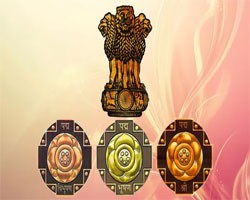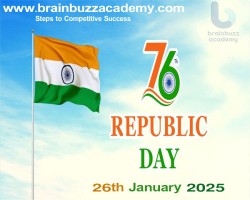UPSC Current Affairs
TABLE OF CONTENTS |
| Awards |
|---|
|
|
|
Context:
The Centre announced the list of recipients for Padma Awards on Saturday on the eve of the Republic Day. The President approved the conferment of 139 Padma Awards, comprising seven Padma Vibhushan, 19 Padma Bhushan and 113 Padma Shri Awards. In the list of awardees, 23 were women and ten were from the category of foreigners/NRI/PIO/OCI. At least 13 people were awarded posthumously. Key Points: The Padma awards, among the country’s highest civilian honours, are conferred in three categories – Padma Vibhushan, Padma Bhushan, and Padma Shri. The Awards are given in various disciplines / fields of activities, viz.- art, social work, public affairs, science and engineering, trade and industry, medicine, literature and education, sports, civil service, etc. ‘Padma Vibhushan’ is awarded for exceptional and distinguished service; ‘Padma Bhushan’ for distinguished service of high order and ‘Padma Shri’ for distinguished service in any field. The awards are announced on the occasion of Republic Day every year. Among the awardees is Harvinder Singh, a para-archer from Kaithal, Haryana, known as “Kaithal ka Eklavyaz’, who became the first Indian to win gold at the 2024 Paralympic Games. He was awarded the Padma Shri. The Padma Shri list also featured cervical cancer specialist Neerja Bhatla and Kuwaiti yoga enthusiast Shaikha AJ Al Sabah. Libia Lobo Sardesai, 100, who played an important role in Goa’s freedom movement, cofounded an underground radio station — ‘Voz da Liberdabe (Voice of Freedom)’ — in a forested area in 1955 to rally people against the Portuguese rule. Gokul Chandra Dey, a 57-year-old Dhak player from West Bengal, who broke the gender stereotype by training 150 women in the male-dominated field, was also conferred the prestigious award. Complete Award List of Winners: Padma Vibhushan: Duvvur Nageshwar Reddy (Medicine) Jagdish Singh Khehar (Public Affairs) Kumudini Rajnikant Lakhia (Art) Lakshminarayana Subramaniam (Art) MT Vasudevan Nair (Literature and Education) Osmau Suzuki (Trade and Industry) Sharda Sinha (Art) Padma Bhushan Surya Prakash (Literature and Education) Anant Nag (Art) Bibek Debroy (Posthumous) (Literature and Education) Jatin Goswami (Art) Jose Chacko Periappuram (Medicine) Kailash Nath Dikshit (Posthumous) (Archeology) Manohar Joshi (Posthumous) (Public Affairs) Nalli Kuppuswami Chetti (Trade and Industry) Nandamuri Balakrishna (Art) PR Sreejesh (Sports) Pankaj Patel (Trade and Industry) Pankaj Udhas (Posthumous) (Art) Rambahadur Rai (Literature and Education- Journalism) Sadhvi Ritambhara (Social Work) S Ajith Kumar (Art) Shekhar Kapur (Art) Shobana Chandrakumar (Art) Sushil Kumar Modi (Public Affairs) Vinod Dham (Science and Engineering) Padma Shri Adwaita Charan Gadanayak (Art) Achyut Ramchandra Palav (Art) Ajay V Bhatt (Science and Engineering) Anil Kumar Boro (Literature and Education) Arijit Singh (Art) Arundhati Bhattacharya (Trade and Industry) Arunoday Saha (Literature and Education) Arvind Sharma (Literature and Education) Ashok Kumar Mahapatra (Medicine) Ashok Laxman Saraf (Art) Ashutosh Sharma (Science and Engineering) Ashwini Bhide Deshpande (Art) Baijnath Maharaj (Spiritualism) Barry Godfray John (Art) Begam Batool (Art) Bharat Gupt (Art) Bheru Singh Chouhan (Art) Bhim Singh Bhavesh (Social Work) Bhimavva Doddabalappa Shillekyathara (Art) Budhendra Kumar Jain (Medicine) C S Vaidyanathan (Public Affairs) Chaitram Deochand Pawar (Social Work) Chandrakant Sheth (Posthumous) (Literature and Education) Chandrakant Sompura (Architecture) Chetan E Chitnis (Science and Engineering) David R Syiemlieh (Literature and Education) Durga Charan Ranbir (Art) Farooq Ahmad Mir (Art) Ganeshwar Shastri Dravid (Literature and Education) Gita Upadhyay (Literature and Education) Gokul Chandra Das (Art) Guruvayur Dorai (Art) Harchandan Singh Bhatty (Art) Hariman Sharma (Others – Agriculture) Harjinder Singh Srinagar Wale (Art) Harvinder Singh (Sports) Hassan Raghu (Art) Hemant Kumar (Medicine) Hriday Narayan Dixit (Literature and Education) Hugh and Colleen Gantzer (Posthumous) (Literature and Education – Journalism) Inivalappil Mani Vijayan (Sports) Jagadish Joshila (Literature and Education) Jaspinder Narula (Art) Jonas Masetti (Others – Spiritualism) Joynacharan Bathari (Art) Jumde Yomgam Gamlin (Social Work) K. Damodaran (Others – Culinary) K L Krishna (Literature and Education) K Omanakutty Amma (Art) Kishore Kunal (Posthumous) (Civil Service) L Hangthing (Others – Agriculture) Lakshmipathy Ramasubbaiyer (Literature and Education – Journalism) Lalit Kumar Mangotra (Literature and Education) Lama Lobzang (Posthumous) (Others – Spiritualism) Libia Lobo Sardesai (Social Work) M D Srinivas (Science and Engineering) Madugula Nagaphani Sarma (Art) Mahabir Nayak (Art) Mamata Shankar (Art) Manda Krishna Madiga (Public Affairs) Maruti Bhujangrao Chitampalli (Literature and Education) Miriyala Apparao (Posthumous) (Art) Nagendra Nath Roy (Literature and Education) Narayan (Bhulai Bhai) (Posthumous) (Public Affairs) Naren Gurung (Art) Neerja Bhatla (Medicine) Nirmala Devi (Art) Nitin Nohria (Literature and Education) Onkar Singh Pahwa (Trade and Industry) P Datchanamoorthy (Art) Pandi Ram Mandavi (Art) Parmar Lavjibhai Nagjibhai (Art) Pawan Goenka (Trade and Industry) Prashanth Prakash (Trade and Industry) Pratibha Satpathy (Literature and Education) Purisai Kannappa Sambandan (Art) R Ashwin (Sports) R G Chandramogan (Trade and Industry) Radha Bahin Bhatt (Social Work) Radhakrishnan Devasenapathy (Art) Ramdarash Mishra (Literature and Education) Ranendra Bhanu Majumdar (Art) Ratan Kumar Parimoo (Art) Reba Kanta Mahanta (Art) Renthlei Lalrawna (Literature and Education) Ricky Gyan Kej (Art) Sajjan Bhajanka (Trade and Industry) Sally Holkar (Trade and Industry) Sant Ram Deswal (Literature and Education) Satyapal Singh (Sports) Seeni Viswanathan (Literature and Education) Sethuraman Panchanathan (Science and Engineering) Sheikha Shaikha Ali Al-Jaber Al-Sabah (Medicine) Sheen Kaaf Nizam (Shiv Kishan Bissa) (Literature and Education) Shyam Bihari Agrawal (Art) Soniya Nityanand (Medicine) Stephen Knapp (Literature and Education) Subhash Khetulal Sharma (Others – Agriculture) Suresh Harilal Soni (Social Work) Surinder Kumar Vasal (Science and Engineering) Swami Pradiptananda (Kartik Maharaj) (Others – Spiritualism) Syed Ainul Hasan (Literature and Education) Tejendra Narayan Majumdar (Art) Thiyam Suryamukhi Devi (Art) Tushar Durgeshbhai Shukla (Literature and Education) Vadiraj Raghawendracharya Panchamukhi (Literature and Education) Vasudeo Kamath (Art) Velu Aasaan (Art) Venkappa Ambaji Sugatekar (Art) Vijay Nityanand Surishwar Ji Maharaj (Others – Spiritualism) Vijayalakshmi Deshamane (Medicine) Vilas Dangre (Medicine) Vinayak Lohani (Social Work) Last year, the Centre conferred 132 people with the prestigious awards, including Former Vice President Venkaiah Naidu, actors Konidela Chiranjeevi, Mithun Chakraborty and singer Usha Uthup. The list comprised 5 Padma Vibhushan, 17 Padma Bhushan and 110 Padma Shri Awards. |
| Important Days |
|
|
|
Context:
Every year, Republic Day is marked on January 26. In 2025, India is celebrating its 76th Republic Day. On this day, the Constitution of India was adopted, and our country became a Republic. Republic Day 2025 theme: The theme of Republic Day 2025 is Swarnim Bharat – Virasat aur Vikas' (Golden India – Heritage and Development), reflecting India's rich cultural heritage and its ongoing journey of progress. Republic Day 2025 chief guest: Indonesian President Prabowo Subianto will be the chief guest for Republic Day 2025, marking a significant milestone in the 75th anniversary of diplomatic relations between India and Indonesia. Republic Day significance: The significance of Republic Day is multifaceted. First, it highlights the commitment to constitutional values: it reflects India's commitment to democratic ideals of justice, liberty, equality, and fraternity. It is also a celebration of India's cultural heritage. The cultural events and tableaux presented during the celebrations showcase India's rich cultural diversity. Another major highlight of the national holiday is the promotion of national unity as the celebrations promote unity in diversity, highlighting India's strength in its diversity. Republic Day also pays tribute to and honours the valour and sacrifice of the leaders and freedom fighters who helped India become independent and build a republic. What is the History of Republic Day? About: Republic Day commemorates the adoption of the Constitution of India on 26th January 1950, and the country’s transition to a republic which came into effect on 26th January 1950. The constitution was adopted by the Constituent Assembly of India on 26th November 1949 and came into effect on 26th January 1950. The Constitution of India repealed the Indian Independence Act 1947 and Government of India Act 1935 when it became effective on 26th January 1950. India ceased to be a dominion of the British Crown and became a sovereign, democratic republic with a constitution. History: Declaration of Poorna Swaraj: The Lahore Session of the INC in December 1929 passed the historic "Poorna Swaraj" resolution, calling for total self-rule/sovereignty and complete independence from British rule. The Declaration of Independence was officially promulgated on 26th January 1930, and the Congress urged Indians to celebrate "independence" on that day. Republic Day in Post-Independence India: From 1930 to 1947, 26th January was celebrated as "Independence Day" or "Poorna Swaraj Day." India gained independence on 15th August 1947, leading to a reevaluation of the significance of Republic Day. The selection of 26th January for the promulgation of India's new constitution was ideal due to its existing nationalist significance and alignment with the "Poorna Swaraj" declaration. Note: On Republic Day every year, the President of India, who is the head of state, ‘unfurls’ the tricolour, while on Independence Day (August 15), the prime minister, who heads the Union government, ‘hoists’ the national flag. While the two terms are often used interchangeably, these represent different techniques of presenting the tricolour. On 26th January, the flag is folded or rolled, and attached to the top of a pole. It is then unveiled (‘unfurled’) by the President, who does so without pulling it up. ‘Unfurling’ is a symbolic gesture to renew the commitment to principles laid down in the Constitution, highlighting India's shift from being a British colony to becoming a sovereign, democratic Republic. On 15th August, on the other hand, the flag, positioned at the bottom of the pole, is raised ('hoisted') by the prime minister, from the bottom to the top. Hoisting symbolises the rise of a new nation; patriotism, and freedom, from colonial rule. |
|
|
|
Why in the News?
World Leprosy Day, observed annually on the last Sunday of January, will be celebrated on January 26, 2025. This global awareness day aims to reduce stigma, encourage early diagnosis, and promote treatment of leprosy, or Hansen’s disease. The 2025 theme, “Unite. Act. Eliminate.”, calls for a collaborative effort to eradicate leprosy and support those affected by it. Key Takeaways Date and Theme: World Leprosy Day 2025 will be observed on January 26, with the theme “Unite. Act. Eliminate.” highlighting the need for collective action against leprosy. Global Goals: The theme emphasizes three key aspects: Unite: Collaboration between governments, NGOs, healthcare providers, and communities. Act: Proactive measures like public education, early diagnosis, and prompt treatment. Eliminate: Aligning with the World Health Organization’s (WHO) goal of eradicating leprosy globally. Leprosy and NTDs: Recognized as a neglected tropical disease (NTD), leprosy’s awareness initiatives align with World NTD Day to address common challenges. Do You Know? Leprosy is often associated with stigma and discrimination, despite being curable with early treatment. This makes awareness efforts vital to debunk misconceptions and promote inclusion. In India, World Leprosy Day is observed on January 30 to honor Mahatma Gandhi’s advocacy for those affected by the disease. Static Points about World Leprosy Day Event Date: January 26, 2025 2025 Theme: “Unite. Act. Eliminate.” Observed Since: 1954, initiated by Raoul Follereau. Significance in India: Observed on January 30 to commemorate Mahatma Gandhi’s compassion for leprosy patients. Challenges: Persistent stigma, delayed diagnosis, and limited healthcare access. How to Get Involved Educate Yourself: Learn about leprosy’s causes, symptoms, and treatment. Support Organizations: Contribute to NGOs and initiatives working to eliminate leprosy. Raise Awareness: Use social media and local events to spread accurate information. Advocate Inclusion: Promote policies that ensure equal opportunities and reduce discrimination. History of the Day World Leprosy Day was established in 1954 by Raoul Follereau to combat stigma and raise global awareness. The date was chosen to coincide with Mahatma Gandhi’s death anniversary, recognizing his tireless efforts to support those affected by leprosy. Conclusion World Leprosy Day 2025, with its theme “Unite. Act. Eliminate.”, underscores the importance of collective action to eradicate leprosy. By raising awareness, challenging stigma, and advocating for early diagnosis and treatment, global efforts can pave the way for a leprosy-free future. |
|
<< 25-Jan-25
|
|
|


